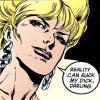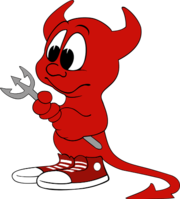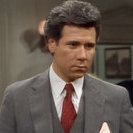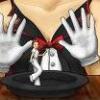Leaderboard
Popular Content
Showing content with the highest reputation on 01/05/2017 in all areas
-

Help Needed from Sci/Fi People
DemonGoddess and 3 others reacted to darthel0101 for a topic
Carbon scatter caused by excess methane and carbon dioxide in the atmosphere impacting the alien's ability to lock onto specific carbon chains associated with their targeted individual.4 points -
Writing Descriptions When we walk through the world, we’re surrounded by a huge range of things, but we usually don’t notice everything in intimate detail. And that’s because much of what we’re surrounded by just isn’t that important to what we’re currently doing; it’s little more than visual background noise. So when your character walks into a room, just how much of what’s in that room should you describe? In every situation, there are things that need to be described, things that shouldn’t be described, and things that don’t really matter whether you describe them or not. Some people might even cut it down to the first two I just mentioned, and suggest that you never describe anything that isn’t relevant to the story. I disagree with that. While it’s never a good idea to go waffling on describing a whole laundry list of irrelevant crap, mentioning things that might enrich the story in some way is never a bad idea. If it doesn’t enrich the story or a character in any way, though, then leave it out. So what should you describe? You need to provide enough detail to allow the reader to create a visual in their mind that follows your guidelines but is still distinctly their own. People have their own imagination, and we all visualise things differently. By trying to describe every tiny, insignificant detail, you’re attempting to ride rough-shod over their imaginations and force your own into their heads, which can annoy enough to pull them out of the story. By giving your readers the necessary descriptive tools, you allow them to visualise the scene and fill in the blanks, rather than trying to do it all for them. Some writers just love to use extremely flowery language peppered with obsolete words, because they presumably think this makes their descriptions better. Personally, I find this unnecessary at best, annoying and frustrating at worst. You shouldn’t need a dictionary when reading a story. A thesaurus is handy, but make sure your new favourite word hadn’t already fallen out of fashion when Queen Victoria was still a girl. Describing rooms Here’s an example of BAD description and BETTER description. BAD: Stephen turned the door nob and gently pushed the mahogany door, which eased open without a sound. It was a smallish room, perhaps about the size of an average bedroom, or maybe a bit larger. The only light came from a shiny silver candelabra which sat on the mantel over the unlit fireplace. The three candles cast dancing shadows around the room, but there was enough light for him to make out the details. A well-worn three-seater leather couch sat in front of a low, rectangular coffee table. Strewn on the coffee table was a magazine called Country Life, an empty glass, car keys in a small silver dish and a circular metal ashtray filled to the brim with ash and cigarette buts. A wing-backed leather single seater sat near the couch, perched at an oblique angle. The walls were lined with sideboards and glass-fronted cabinets, all stuffed with glass and porcelain ornaments and knick-knacks of all shapes and sizes. What little of the walls he could see were adorned with old-fashioned wallpaper, with stylised patterns of flowers alternating in vertical rows. As Stephen stepped into the room, he felt the thick, shag-pile carpet under his feet. It was hard to tell the exact colour in the dim light, but he thought it was probably a dark red. Taking a seat on the three-seater, Stephen’s first impression was that it wasn’t quite as comfy as he thought it would be; he could feel one or two springs pressing against him. It was only now that he noticed the gentle ticking sound, and saw the mantel clock sitting at the other end of the mantle. BETTER: Stephen eased open the mahogany door without a sound and stepped inside, feeling the plush carpet under his feet. A fireplace sat cold and empty, but a lit candelabra on the mantle cast dancing shadows around the room. The warm glow revealed a busy room bordering on cluttered, but it was the leather lounge in the middle that he made his way to. Leaning back in the slightly uncomfortable chair, Stephen’s gaze fell on the coffee table, showing a small assortment of objects including a glass half full of some dark liquid, but it was the ashtray that caught his attention the most. Ash and cigarette butts filled it to overflowing, with a dusting of ash surrounding it. The ‘better’ description is certainly shorter, but that doesn’t make it worse. Does it really matter exactly how big the room is, that there’s three candles in the candelabra, the other single seater chair, the exact shape of the coffee table, the name of the magazine, the car keys in the dish, the ornaments, the wallpaper, the colour of the carpet, or the clock? I mentioned the ashtray because, in my mind, that has some relevance to the story. Also, describing the half-full glass suggests to the reader that there’s likely to be someone else in the house. If there’s nailhead trim on the leather couch, then mention that, but only if someone is going to snag their clothing on it later, or they subsequently find one of the nailheads elsewhere in the house. Perhaps there’s two empty glasses and a bottle of wine on the coffee table. Or maybe the ornaments are important. But for me, none of that other stuff was significant enough to warrant mentioning. One way you could end up describing more of that room is by having the owner enter the room, strike up a conversation with Stephen and begin talking about some of his ornaments. You’ve already described the fact that the room is cluttered, so the fact that there’s ornaments in the room won’t come as a surprise. On the other hand, if the owner starts talking about the dog in the room then the reader is going to think, ‘Hang on, what dog?’. Adding detail a bit at a time is better than doing it all in one big block of text. When you’re describing an interior, the most important thing is to convey the feel of the room. Is it sparsely furnished or cluttered? Brightly lit or dark and forbidding? Give them enough detail to provide the overall feeling you want, and leave them to furnish the rest of the room in their own minds. Remember, though, if there’s some object in that room that will have significance later in the story then you need to discuss it. The longer you hover over that object, though, the more you tip off the reader that this object is very important. Describing external scenes Describing external scenes can be a lot easier, at least as far as describing landscapes is concerned. Is it a forest dense enough to make it difficult to walk through, or an open forest? Open flat grass plains or rolling hills? You don’t need to – nor should you – attempt to describe every rock and tree. If the weather is cold or hot then you should describe the effect it’s having on the characters. Describe the ice and snow, and how he’s still shivering in spite of his warm clothes. Or how his sweat trickles down his face, and how the sun beats down on him like hammer blows. You shouldn’t need to specifically tell your reader what season it is; that’s what good description is for. If you’re not an architect then describing buildings facades can be difficult, but who wants to read that level of intimate detail? If the style is important – Gothic or Art Deco perhaps – then describe it, but remember that you’re not writing a story on architecture. Describing the condition of the building is important if it’s run-down. Talk about the peeling paint, the cracked and broken windows, the holes in the walls, the kicked in front door; that’s if it’s an abandoned building. If the place is simply run-down rather than abandoned then you’ll probably want to dial that back a bit, unless you wont people to be surprised to find someone still living in it. Describing clothing It’s usually not important what exact clothes your characters are wearing. While you’re spending a full page describing in intimate detail what Samantha is wearing, your reader is working overtime putting all this together and visualising what you’re forcing down their throat. If an item of clothing that she’s wearing will later become significant then discuss that, but only in as much detail as strictly necessary. For example, let’s say Samantha goes jogging. You could mention that she’s wearing her usual tracksuit or active wear, etc, including her old and battered, but comfy, sneakers. You mention the sneakers because later, after she’s been reported missing, these sneakers are found. A detective talking to Samantha’s best friend describes how these shoes are her favourites and was dreading the day she would need to buy new ones, so there’s no way she would simply throw them away. So you could have initially had Samantha having an internal monologue about how these are her favourite shoes, etc, but that’s usually silly and unnecessary, especially when you could have her best friend later relate this information to someone. If the character wears very weird clothing, then describe it; if they’re wearing an ugly tie, then describe it; if there’s something significant about their clothes, then describe it. If you want to convey the idea that it’s hot or cold outside, then describe it. Otherwise, don’t. Describing emotions There’s an old writer’s maxim: Show, don’t tell. You should never have a reason to say “Jeff was angry”. It should be obvious that Jeff was angry from your description. Facial expressions and body language are invaluable in showing what a person is feeling, regardless of what they’re actually saying. Does your character have a nervous tic? Do they blush even more than normal when they’re embarrassed? Or maybe they stammer a bit, or get angry? Do they always scratch an imaginary itch when they’re lying? It should also be obvious that a person is in love with someone, without you needing to type the word ‘love’. Descriptions are vital, but they can also bore readers with great speed. Try and break up your descriptions over various scenes. Bite-sized pieces of descriptions are more palatable than big blocks of them every other paragraph.3 points
-

Help Needed from Sci/Fi People
CL Mustafic and 2 others reacted to DirtyAngel for a topic
ok, 2000 years ago there was no electronic technology on this planet so maybe all the electronic noise we create is messing with the alien’s technology and they have to wait until the person they want to beam up is in a “quiet” spot.3 points -

Trolls - Advice needed
JayDee and 2 others reacted to DirtyAngel for a topic
hunt them down and annihilate them! Burn them so bad their offspring need silvadene1 Crush them and enjoy the screams as their friends and family flee before yo in terror! mwahahaha… too much?3 points -

JayDee's (Originals) review reply, story discussion and additional notes thread
BronxWench and one other reacted to JayDee for a topic
Oh, sure, I get that, in yaoi no matter how apparantly femme someone is, they’re male. In video games it led to everyone’s gay for Bridget. I’ve always been a little unsure about content levels on AO3, that’s why I’ve not posted a whole lot there, but I can’t think The Price would go beyond ‘em. That is, until the readers are lying awake at three in the morning with all the lights on.2 points -

JayDee's (Originals) review reply, story discussion and additional notes thread
JayDee and one other reacted to pippychick for a topic
As someone who primarily writes slash, all characters are male to me. Even the ones pretending to be girls. Even the ones who are girls. Even me… Wait, what?! No!!! I didn’t mean it! *glares at the doctors… throws hands protectively over bosom* Don’t you dare take them off! Ah, thank you. It was written for you, and as long as you like it, you ’re the only one that matters. Maybe I’ll post it on AO3, just so my troll knows what I can do when I really put my mind to it… Excellent! Maybe Sarsa could do yours and DG’s work on an alternating week by week basis, then we’d all be happy! *g*2 points -

JayDee's (Originals) review reply, story discussion and additional notes thread
BronxWench and one other reacted to JayDee for a topic
Thank you for your thoughts! I’ve been trying to do You! as gender neutral, partly because anyone can then feel more into the character and partly because Tumblr now gets upset if you even assume your own characters’ gender. I suspect it’s one of those areas where my lack of ability as a writer lets me down! I think the original plan for part 3 was going to involve some inadvertant wolf-ass-in-face moments to justify the title but with it being over a year I thought there was a nice opportunity to throw in some 2016 gags. It would be kind’ve a shock, huh? That autograph book is going unfilled There’s only one thing that can stop a terrible fanfiction writer. They’re going to have to knuckle down, pool their resources, and get Sarsa a job with a shitty shift pattern. Heh… a little team of heroes. And Lupa. I’m sorry to see you haven’t had more reviews on The Price. It’s a great story.2 points -

Quote from my mum: “Trump has a face like a disappointed fish.”
BronxWench and one other reacted to Melrick for a status update
Quote from my mum: “Trump has a face like a disappointed fish.”2 points -

Trolls - Advice needed
pippychick and one other reacted to darthel0101 for a topic
Trolls are LOOKING for a response. Remember, they got their name, not because they are repulsive bottom feeders (although this in no way prevents this description from being valid) but because they always have a line in the water trying to get a bite. The best way to piss off a troll is to ignore it. Document the abuse but do nothing to the troll or their "conversation". Let admins deal with the documented abuse.2 points -

Creating characters
pippychick and one other reacted to Melrick for a topic
I’m glad people like these! I’m just wondering if I should move them to the “Unofficial Guides” section of the Writer’s Corner.2 points -

Trolls - Advice needed
CloverReef and one other reacted to GeorgeGlass for a topic
Wait, so it’s starve a troll, feed a fever? I always get that mixed up. But yes, agree with everyone that the best response usually is no response.2 points -

Creating characters
Cuzosu and one other reacted to Desiderius Price for a topic
Good reading. After I decide I’ll need a character, I typically use a random picker to give me a list of traits/hobbies/allergies/phobias, and I’ll see if any work for what I want out of the character. If it’s a marginal character, I’ll pick more freely. If there’s a specific/important reason for the character, I’ll be more selective and reselect until I get something closer. And, after I select, I will record them (I’ve got dossier files for each character) – this is perhaps the most critical, because if I work with the character later, I can keep him/her consistent. At the threat of a mild spoiler, this process helped me this week, because a character needed to eat a lot of a particular food. As I was editing his dossier to make it his favourite, I noticed that I had previously made him allergic to it. This suddenly made the character richer in his personality for deliberately eating something he’s allergic to (and suffering the consequences of it later), and strengthened the plot a bit since I no longer had to make it ill-prepared food. So, for me, my process helps me, helps me have a diversity of characters with different traits, and it helps me when writing because it can fill in those awkward moments, like, when one character gives a gift to somebody else, where the friendship is deep, then what’s the gift? My day job involves software so I have to be very rational, logical, and considering subtle nuances; this is something I carry over into my writing. So, maybe somebody else will find my process useful.2 points -

Thoughts on Mr. Peabody and Sherman
DemonGoddess reacted to WritingDude for a topic
The original cartoon was a decent companion piece to The Rocky and Bullwinkle Show. The movie by DreamWorks Animation is difficult to recommend despite good animation and excellent chemistry between Mr. Peabody and Sherman. This is so for 3 reasons: 1. The third act is very convoluted, 2. The villain (if you can call her that) is pathetic, and 3. The lead female character is such a terrible character, I refuse to address her by the name she's given (I call her Skank instead). The new show on Netflix had everything I didn't want in a continuation of the movie; bad animation, an awful theme song, and the personality of the characters stripped in favor of bad jokes and a stupid premise. Overall, the concept of a dog owning a boy instead of the other way around is unique, but these two characters deserve better.1 point -

Suggestions for Archive cleanup and restructure
FairySlayer reacted to DemonGoddess for a topic
I’m actually searching the subdomains one by one, starting with the truncation of bigotry. Any others you find that I can use and fix, I certainly will.1 point -

Suggestions for Archive cleanup and restructure
FairySlayer reacted to BronxWench for a topic
Yes, the query run to move the tags did truncate some. Our coder is correcting those, or at least some of those, at present, and we mods will tackle them as we run across them as well.1 point -

JayDee's (Originals) review reply, story discussion and additional notes thread
BronxWench reacted to JayDee for a topic
Thank you for your review. Sarsa loves to read, it was a dead cert she’d find Harry Potter at some point and then the Sue-ening would be an inevitible consequence. I figure wolves don’t have as much of a concept of time, but You! do. I had some other stuff about how the evil in the internet is responsible for a lot of the bad shit happening, but there’s a word limit on those things. Maybe in You! 4… Lupa’s way angrier about things than Kate. After initially running away, Kate’s accepted a role a follower to Kizzy’s alpha, otherwise she’d have been alpha wolf with her own pack and acting a little differently. Lupa, on the other hand, is still pissed at how hard it is to be an athiest when you’re hanging out with a demon and an angel. Or something. Thanks again but sadly I bet I’m still going to be short of time!1 point -
I’m still intending to do the Willow story when I have time. And that 100 word prompt challenge. But since it’s been over a year since I was able to write anything, an extra chapter of this’n isn’t such a terrible thing. I had trouble keeping it in present tense and probably messed up again despite some re-writing. You! Thank you for your comments. I understand it is not the first chapter I’ve written that has caused peeing. Sarsa’s stories are worse than 2016, because 2016 eventually came to an end but Sarsa is still writing. I may not be back at it for long, I think I’ll have little time1 point
-

Trolls - Advice needed
JayDee reacted to pippychick for a topic
On a more serious note, you are dead right and this is great advice. I notice this morning that they are just wading deeper and deeper into their own trouble, completely oblivious that the admins are going to looking up their comments. They don’t need my help at all On another note, to everyone, even if you come across this trolling, please don’t say anything to them. That particular clear violation of the TOS (encouraging others to attack/harass etc) is what I’ve reported them for.1 point -

Creating characters
pippychick reacted to BronxWench for a topic
Melrick, I think these are perfect for the “Unofficial Guides” section. Honestly, I love these!1 point -

Magusfang's Corner
DemonGoddess reacted to darthel0101 for a topic
Don't go Sumerian. They used base 60. BTW all programming numbering systems but hexadecimal will end up showing higher numeric values. IIRC, sixty can be represented as 001111, 74, or 3C (binary - read 1s/2s/4s/8s/16s/32s, octal - read 8s/1s or hex - read 16s/1s ).1 point -

BashfulScribe's Written Works
Starkz reacted to BashfulScribe for a topic
I’m sorry that it hurt. In a weird way, I’m glad that the message got across. Not everyone knows the pain of having an event like that in your life, and at the very least I’m glad to see that if I went for it, it wasn’t a wasted effort. Also, props for letting your feelings be known and highlighting why without posting any real spoilers. Working on chapter 19 presently.1 point -

a giants human pet
JayDee reacted to Keith Inc. for a topic
Not ALL…. A significant percentage, maybe. Sometimes it’s not a giant. The pet is just shrunk...1 point -

Magusfang's Corner
Flexy68 reacted to DirtyAngel for a topic
thanks guys and I’m not older, I’m a classic1 point -

Help Needed from Sci/Fi People
CL Mustafic reacted to Desiderius Price for a topic
Not certain, the sunspot number is going down. (Which means less activity.) However, there is a random chance factor, that unless somebody is looking up NOAA’s space weather page, can be easily fudged to make the plot happen.1 point -

Help Needed from Sci/Fi People
CL Mustafic reacted to pippychick for a topic
That’s a good one… hasn’t the sun been quite active with solar flares recently too? Or am I just imagining that?1 point -

Help Needed from Sci/Fi People
CL Mustafic reacted to Desiderius Price for a topic
While I wanted to reply at work, I figured I ought to be working at work…. (not to mention, replying on the tablet is painful). Several different ways, depending on whether you’ve got a receiver pad, or not, and whether it’s got to be permanent or just temporary. Obviously, with a permanent receiver pad/device on Earth, it could be moved, defaced, destroyed by us, or be used as a chamber pot by some soul who doesn’t realize what it is. Now you could go with electromagnetic interference because that has changed in 2017 years, choosing your favorite gadget for causing this, on the “specific frequency” needed for the beaming to work. (ie, microwave, or wifi blaming our porn habits, or, if you need night time only, the sodium vapor common in street lights) Another possibility is pollution in the atmosphere, blocking the frequencies needed for the beam in/out to work. A non-human possibility is a geomagnetic storm (ie, a solar flare) from the sun. Several ideas, hope it helps!1 point -

Week 246 - 1 January 2017
DemonGoddess reacted to JayDee for a topic
Pen Name: JayDee Story link: You! - Part 3: Wolf Moon Review replies link: Review Replies -Original Type of fic: Flashfic Rating: Adult + Fandom: Original Pairing: Still isn't one. Warnings: AFFO, ChallengeFic, Exhib, Hum, TF1 point -
I agree, they’re interesting little reads.1 point
-

The Art of Foreshadowing
Wilde_Guess reacted to Melrick for a topic
The Art of Foreshadowing What is it? Quite simply, foreshadowing is to hint at something, in a casual way, where it will be brought up again later on in the story in a more significant and relevant way. The ‘art’ is in exactly how you lay that little hint, without telegraphing “THIS IS IMPORTANT! REMEMBER IT!”. Why it’s important Story telling is easy. No, really, it is! The art is in how you tell the story, that’s what makes it scary, exciting, sexy, etc. Foreshadowing is a very important tool to use in many, if not most, stories. I’m sure most of us have watched movies where all of a sudden, the hero just happens to find the one thing he or she needs to save the day. “Oh that was convenient!” we shout at the screen. It’s far too convenient, and therefore, annoying, for the hero of your story to miraculously find exactly the right thing he or she needs right when they need it the most. This is the reaction you’ll get for unrealistic and unbelievable story telling. What you need to do is to leave a little hint earlier in the story, something that, at the time, didn’t seem all that relevant or important to the story, but allows the reader to later say, “Oh, so that’s why the author did that!” Foreshadowing is more important in some stories than others. Detective mysteries rely very heavily on foreshadowing. Everyone reading the story is hoping to guess who the killer is before the detective, and a well written story should provide enough hints to allow the reader to do this, if only they work out what’s important and what’s a red herring. There’s nothing worse than coming to the conclusion and realising that the detective was apparently privy to information that we, the reader, were not. This is bitterly frustrating and poor story telling. When the detective goes through the steps that allowed him or her to catch the killer, everything there should be something that the reader could also have picked up on. Nothing should be a clue that we hadn’t been exposed to in some way. As suggested above, you can also use foreshadowing to misdirect the reader, by laying a hint that you know the reader will think is important but is actually a red herring. You would then follow it up a little later with another hint – the true one, this time – but because the reader has thought the earlier hint was the real one, they might be tempted to overlook the true one. I think you’d need to be a little careful with how you do this, because it can backfire if done poorly. If done right, though, then it can be a clever way to get the reader to watch your left hand while your right pulls the card out of your sleeve. On the other hand, some stories, like detective stories, rely very heavily on leaving plenty of clues and red herrings, creating a pretty tangled web that needs to be weaved with great care. This is why a good detective story can be so difficult to write. Huge respect to Agatha Christie! How and when to foreshadow More often than not, foreshadowing should be of the fairly subtle kind. If it’s shouted from the rooftops then it can cause the reader to keep a close eye out for it, so when it happens, it’s of no surprise at all to the reader, and, frankly, spoils the story. A better way is to drop the hint in such a way as to cause the reader to either all but forget about it, or to make the reader think that your hint was just a bit of flavouring, and nothing more important than that. You can go overboard with foreshadowing though. If everything in your story is important, then the reader soon learns to understand that everything you mention is going to have something relevant to do with the climax of your story, which only helps to lessen the impact. By adding things to your story that aren’t important, it ensures the reader is never sure what’s important and what’s not. On the other hand, when you later proofread your story, you might actually see how you could turn one of these story flavour enhancers into an actual foreshadow. But as I said, these ‘story flavour enhancers’ should rarely be promoted as “THIS IS IMPORTANT” moments. Describing how the ashtray on the coffee table is overflowing with ash and cigarette butts might just be a way to simply show that the occupant is a smoker and a bit messy or lazy, or it might have important relevance later on. Who knows? Certainly not the reader, and that’s what’s most important. Remember, foreshadowing should very rarely be obvious. It should be a fairly subtle hint that the reader may or may not pick up on. Too overt a hint comes across as too obvious and too forced. It needs to flow naturally with the story, appearing as something that is nothing more than a flavour enhancer.1 point -
If you’ve been carefully following Melrick’s posts you’ll have been able to work out this guide was coming for some time.1 point
-

Creating characters
Melrick reacted to pippychick for a topic
Melrick, I am loving all these little snippets you are posting – they’re fantastic!1 point -

a giants human pet
JayDee reacted to DemonGoddess for a topic
You need to read Keith’s stuff. That’s what he writes!1 point
